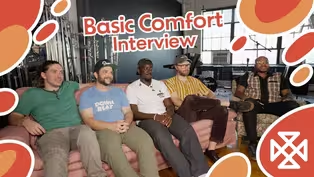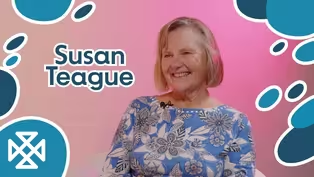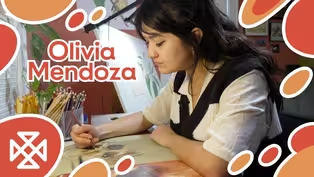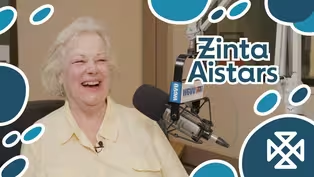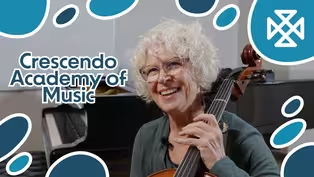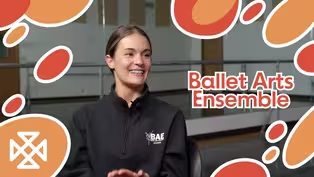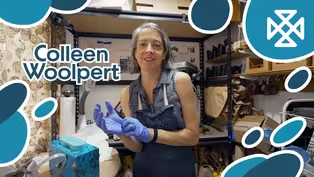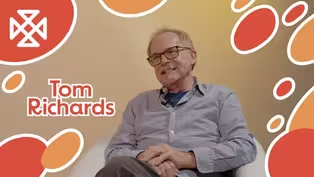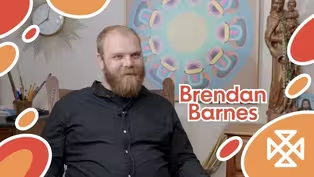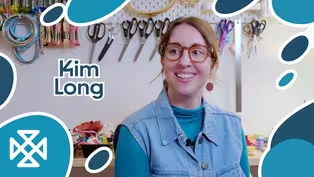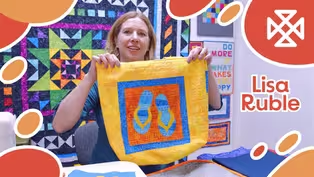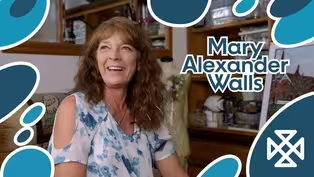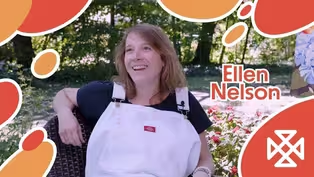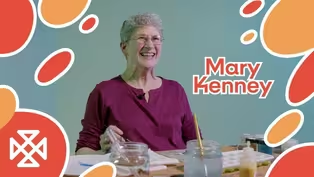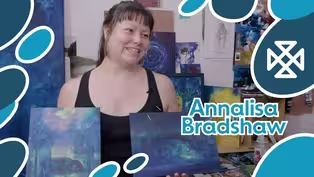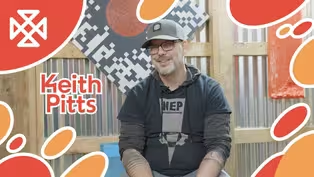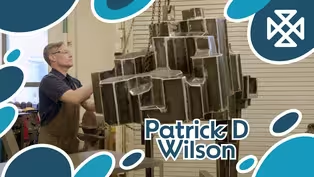Kalamazoo Lively Arts
The Artist's Pantheon
Clip: Season 9 | 12m 27sVideo has Closed Captions
Susan Teague uses the experience of life to create her own set of art.
Susan Teague uses the experience of life to create her own set of Goddesses which celebrate the modern woman and how incredible she is. You will laugh and learn from Susan weather you read her book or are a student in her painting classes.
Problems playing video? | Closed Captioning Feedback
Problems playing video? | Closed Captioning Feedback
Kalamazoo Lively Arts is a local public television program presented by WGVU
Kalamazoo Lively Arts
The Artist's Pantheon
Clip: Season 9 | 12m 27sVideo has Closed Captions
Susan Teague uses the experience of life to create her own set of Goddesses which celebrate the modern woman and how incredible she is. You will laugh and learn from Susan weather you read her book or are a student in her painting classes.
Problems playing video? | Closed Captioning Feedback
How to Watch Kalamazoo Lively Arts
Kalamazoo Lively Arts is available to stream on pbs.org and the free PBS App, available on iPhone, Apple TV, Android TV, Android smartphones, Amazon Fire TV, Amazon Fire Tablet, Roku, Samsung Smart TV, and Vizio.
Providing Support for PBS.org
Learn Moreabout PBS online sponsorship(bright music) Susan Teague, congratulations on much success you you’ve had been followed in your life, including, are you best known for this 9,000 square foot painted mirror at the New Bronson Children’s hospital?
Yes.
Yes, so back in the year 2000, Bronson Hospital was being built to say the process.
And they were looking for some Muralists to paint 4000 the first 4000 square feet.
And so I submitted a proposal and they liked the idea and voila, for that was my first four thousand square feet in the children’s hospital.
When did you know you were going to be an artist as a a lifelong talent?
Believe it or not, it was three years old.
My mother is an artist or was an artist she’s since passed.
and I was in the hospital for some reason at age three and my mom decided that she was going to bring me paint and canvas and how brave of her because it was oils.
So I sat there in that little hospital bed and I painted my little heart out and I knew that’s exactly what I wanted to do.
And I have.
Fill in a gap between now and maybe that first job after college.
What how was the career progression?
in art?
Well, I was married when I was in college, and so art I was still working with it, but not seriously because I was tending to children.
My first experience was illustrating a book, a literary book, and that was published in two of those, and then it was another book and then another book that I illustrated.
And then I got a call to go to the Art Institute to start teaching there.
And that really opened up my career because I got to study with five internationally recognized artists through the influence of being there.
It was amazing what I had learned.
And so from there, it the teaching was a big part.
I realized how much I love teaching.
I’m very good as an instructor.
One of the things that I’ve encountered in my 30s really actually 40 some years as an artist is that people will say to me whether they’re students or friends, that they really want to paint, but they’re frustrated because they it looks like mud and they don’t wanna don’t how to fix it.
And so I’ve put together this opportunity here for an understanding of what color can do and what it can’t do.
So here is a color wheel, the mixtures of the primary colors, the secondary colors and the tertiary colors.
And what is very simple to understand is that once you start mixing colors that are opposite each other on the color wheel, they turn to mud.
And that mud is kind of a neutral color.
It’s not warm, like it is up here and it’s not cool, like it’s down here, it’s neutral.
So in a painting, we would want pure colors.
We would want semi neutrals and we would want these neutrals that are in here.
So I thought I’d tell you that we’ve got nine different color schemes that are proven harmonious color palates that will go if you use them, they’re going to be successful, turn out to be successful paintings.
The first one is called monochromatic.
And that’s just simply monoaning one, chrom meaning color, and we’ll just take one color, and I have blue over here.
and we would just take this and we could make mixtures and I would take that color and I could maybe make this really a dark shadow down and through here.
I could take some white and make that much lighter color up here, like so.
But all of this would be variations of just one color.
Not many artists will tend to just work with one color, but it is guaranteed to be harmonious when you’re done with it.
It can be very pleasing.
And here’s the value up here that’s much lighter.
So you have all these variations of one color.
Then we get a little more complex.
We go into a complementary color scheme.
orange and a blue They’re actually opposite down to the color wheel.
If I start mixing these together here, like so, and I’ll take a little bit of that blue and mix it together.
I’m going to get a nice shadowy color back in the wall on that back wall.
This is where your mud and colors will come in very handy because you don’t want everything to be bright and brilliant, then the viewer’s not going to know what to look at.
And then I will take the orange.
Warm colors come forward.
They look like they come in front of everything else.
I’ll put our warm colors up close.
Like here.
Add a little white to that for a lighter value.
And then I will just put blue on the table here, straight pure blue.
And then what I’m going to do is makes a little bit of orange with that, that blue just a dot.
Now, if I stepped back and I looked at this and I said, okay, well, I got a light and medium in a darker value here.
But boy, that blue stands out like a sore thumb.
So then I can go back and do another variation.
I can mix a little bit more blue with this to that orange, maybe add a little white to it to soften that up a bit.
And now I have this neutral color and I’m gonna put right on top of it.
And it softens that up.
Okay, so that would be the complementary scheme.
Moving into now three colors.
This is what we call a split complementary.
That means instead of going across the wheel like this or like this, we’re going to split it.
Instead of going straight across, we’re going to do this across.
This is where orange would be.
We’re going to split here, like so.
So I’m going to take the same colors.
I’m using yellow orange and red orange.
blue first here.
Make this the shadow.
That’s got orange added to it.
And then I’m going to take my uh yellow in here because it’s yellow orange.
put this on the side.
So I’m gonna take my little bit of my red, a little bit of my orange, and get this value right through here.
I could put this then as a background.
If I do this, we’re going to see that that bright color so aggressive that it’s going to stand out like a sore thumb.
So it would be better, in compositions and in your paintings, to create the bright colors for your objects that are important.
So I would have reversed.
I would put that here and this in the background.
If I’m not liking that, I can just simply, okay, I’m going to take this color and I’m going to add some blue to that.
So now I have got my orange, red, my yellow orange, and I’ve got my blue and I’m mixing it together like this, and change it up.
Okay, so those are three of the color schemes, monochromatic, complementary, split complementary.
Back to present day, what continues to inspire you?
Oh I don’t mean to be trite about this, but everything.
I’m meaning that with all of my heart, because life experiences when they happen, they go into the well inside.
And when that bucket of experience is is full and it jell, it pops out into an idea.
This friend of mine, who’s an artist, as an art teacher at elementary school, uh was retiring.
She gave me a box of colored tissue paper so big like this.
And she said, I want you to have this.
And I thought, I don’t want to to do with this.
I mean, I’t tell I didn’t know.
I said, thank you.
Yes.
And I appreciate it.
And I believe everything works together for good.
So I didn’t throw it away, sat in my studio for four years.
I went to California to jury an art exhibition, walked into the Mission Inn where they have stained glass windows.
Thank you.
They’re they’re from floor to ceiling.
Extraordinarily beautiful.
I saw one that had an icon in the middle of it and I thought that tissue paper color, I thought I could turn that to make it look like it’s a stained glass window.
And I’m going to do something with an icon with women.
But you know, it’s that’s the gelling point.
It’s when something’s brewing on the inside and it wants to say something.
You don’t quite know what it is and you just take the lead.
You let it you let it flow through you unexpected.
And so I went home and I made to begin with, I made seven, eight foot high, four foot wide icons of fictitious goddesses.
And the first icon that came out was Diana, DYE dash ANN A.
And it’s a woman standing in a salon holding dye bottles and her hair is all multicolored.
and went into another one germaine.
She was holding all these disinfectant cleaners, and she’s standing there with all the mops and so on, and she’s the goddess of disinfectants.
And all of these, I don’t know, again, why am I why am I doing all this?
Well, what happened after I did 16 of these play on words?
It became an art exhibition and that turned into something much deeper.
That was a really well-favored exhibition here at Art Prize in the year 2010.
And Ripley’s believe it or not came, they purchased for them for their Orlando Museum.
But the people photographing them and photographing and photographing while I was there, I thought I’m onto something here.
There’s some people are relating to it.
It turned into a book in which I wrote stories about these goddesses, but they’re true humorous, but true stories about women.
so the exhibition is celebrating the contemporary woman in her gal spectacular humanness in her everyday story.
But yet at the same time, speaking to the core essence of her as a goddess in today’s world.
Thank you for being here, Susan.
Thank you.
Appreciate being here.
- Thank you so much for watching.
There's also more to explore with "Kalamazoo Lively Arts" on YouTube, Instagram, and wgvu.org.
We'll see you next time.
- [Announcer] Support for "Kalamazoo Lively Arts" is provided by the Irving S. Gilmore Foundation.
Helping to build and enrich the cultural life of greater Kalamazoo.
Connected by the Beat: A Conversation with Basic Comfort
Video has Closed Captions
Clip: S9 | 12m 17s | Hear from the band members on what drives them to create funky and sonically solid music. (12m 17s)
Video has Closed Captions
Clip: S9 | 12m 27s | Susan Teague uses the experience of life to create her own set of art. (12m 27s)
Video has Closed Captions
Clip: S9 | 14m 1s | Olivia is passionate about nature and accuracy, capturing intricate details of nature. (14m 1s)
Video has Closed Captions
Clip: S9 | 11m 32s | A conversation with WMUK's Zinta Aistars. (11m 32s)
Video has Closed Captions
Clip: S9 | 13m 39s | Explore the inspiring world of the Crescendo Academy of Music in Kalamazoo! (13m 39s)
Video has Closed Captions
Clip: S9 | 12m 3s | Step behind the scenes of the Ballet Arts Ensemble in Kalamazoo! (12m 3s)
Video has Closed Captions
Clip: S9 | 12m 3s | Colleen Woolpert creates her own stereoscopes to share her experiences with the world! (12m 3s)
Video has Closed Captions
Clip: S9 | 13m 26s | Tom Richards is a potter who uses an eclectic mix of materials to create truly unique pottery! (13m 26s)
Video has Closed Captions
Clip: S9 | 13m 44s | Heirloom Arts Tattoo aims to create a safe space for LGBTQIA+, BIPOC and neurodivergent folks! (13m 44s)
Video has Closed Captions
Clip: S9 | 11m 25s | Brendan Barnes wants to recapture a sense of wonder using mystery, the unknown, and vivid colors! (11m 25s)
Video has Closed Captions
Clip: S9 | 13m 6s | Kim Long brings whimsical floral designs to felt embroidery! (13m 6s)
Sew Little Fabric, Sew Little Time
Video has Closed Captions
Clip: S9 | 12m 18s | Lisa Ruble sews modern designs and improvisational techniques for a fresh take on quilting. (12m 18s)
Video has Closed Captions
Clip: S9 | 13m 49s | Mary Alexander Walls incorporates form, movement, and most importantly color into her mosaics. (13m 49s)
Video has Closed Captions
Clip: S9 | 11m 20s | Ellen Nelson reaches into the unknown to find what it means to live in those in-between moments. (11m 20s)
Egg-cellent Paintings with Egg Tempera
Video has Closed Captions
Clip: S9 | 14m 49s | Mary Kenney is a painter, but uses a special ingredient in her pigments. Egg! (14m 49s)
Video has Closed Captions
Clip: S9 | 10m 32s | Annalisa combines light, color, space, and mythology in her oil paintings. (10m 32s)
Shimmering Shadows: Owls and Crows in Gold Leaf
Video has Closed Captions
Clip: S9 | 13m 16s | Karen Bondarchuk guides us through her fascination with corvids and birds! (13m 16s)
Video has Closed Captions
Clip: S9 | 11m 46s | Alexa Karabin shows the magic of making her own paper to paint on. (11m 46s)
Video has Closed Captions
Clip: S9 | 13m 1s | Keith Pitts defies expectations of what a painting can be on Kalamazoo Lively Arts. (13m 1s)
Video has Closed Captions
Clip: S9 | 11m 55s | Patrick D Wilson lights the torch and welds together thousands of pieces of steel! (11m 55s)
Providing Support for PBS.org
Learn Moreabout PBS online sponsorshipSupport for PBS provided by:
Kalamazoo Lively Arts is a local public television program presented by WGVU
